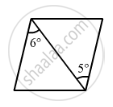Advertisements
Advertisements
प्रश्न
A thin prism of angle 6.0°, ω = 0.07 and μy = 1.50 is combined with another thin prism having ω = 0.08 and μy = 1.60. The combination produces no deviation in the mean ray. (a) Find the angle of the second prism. (b) Find the net angular dispersion produced by the combination when a beam of white light passes through it. (c) If the prisms are similarly directed, what will be the deviation in the mean ray? (d) Find the angular dispersion in the situation described in (c).
उत्तर
Given:-
For the first prism,
Angle of prism, A' = 6°
Angle of deviation, ω' = 0.07
Refractive index for yellow colour, μ'y = 1.50
For the second prism,
Angle of deviation, ω = 0.08
Refractive index for yellow colour, μy= 1.60
Let the angle of prism for the second prism be A.
The prism must be oppositely directed, as the combination produces no deviation in the mean ray.
(a) The deviation of the mean ray is zero.
Thus, we have:-
δy = (μy – 1)A – (μ'y – 1)A' = 0
∴ (1.60 – 1)A = (1.50 – 1)A'
`rArrA=(0.50xx6^o)/0.60=5^o`

(b) Net angular dispersion on passing a beam of white light:-
(μy – 1)ωA – (μy – 1)ω'A'
⇒ (1.60 – 1)(0.08)(5°) – (1.50 – 1)(0.07)(6°)
⇒ 0.24° – 0.21° = 0.03°

(c) For the prisms directed similarly, the net deviation in the mean ray is given by
δy = (μy – 1)A + (μy – 1)A'
= (1.60 – 1)5° + (1.50 – 1)6°
= 3° + 3° = 6°
(d) For the prisms directed similarly, angular dispersion is given by
δv – δr = (μy – 1)ωA – (μy – 1)ω'A'
= 0.24° + 0.21°
= 0.45°
APPEARS IN
संबंधित प्रश्न
What is the cause of dispersion of light
For any prism, prove that :
'n' or `mu = sin((A + delta_m)/2)/sin(A/2)`
where the terms have their usual meaning
Out of blue and red light which is deviated more by a prism? Give reason.
Can the dispersive power \[\omega = \frac{\mu_u - \mu_r}{\mu - 1}\] be negative? What is the sign of ω if a hollow prism is immersed into water?
If a glass prism is dipped in water, its dispersive power ___________ .
A prism can produce a minimum deviation δ in a light beam. If three such prisms are combined, the minimum deviation that can be produced in this beam is _______________.
A thin prism is made of a material having refractive indices 1.61 and 1.65 for red and violet light. The dispersive power of the material is 0.07. It is found that a beam of yellow light passing through the prism suffers a minimum deviation of 4.0° in favourable conditions. Calculate the angle of the prism.
The minimum deviations suffered by, yellow and violet beams passing through an equilateral transparent prism are 38.4°, 38.7° and 39.2° respectively. Calculate the dispersive power of the medium.
Two prisms of identical geometrical shape are combined with their refracting angles oppositely directed. The materials of the prisms have refractive indices 1.52 and 1.62 for violet light. A violet ray is deviated by 1.0° when passes symmetrically through this combination. What is the angle of the prisms?
The refractive index of a material M1 changes by 0.014 and that of another material M2 changes by 0.024 as the colour of the light is changed from red to violet. Two thin prisms, one made of M1(A = 5.3°) and the other made of M2(A = 3.7°) are combined with their refracting angles oppositely directed. (a) Find the angular dispersion produced by the combination. (b) The prisms are now combined with their refracting angles similarly directed. Find the angular dispersion produced by the combination.
The deviation produced for violet, yellow and red lights for crown glass are 3.75°, 3.25° and 2.86° respectively. Calculate the dispersive power of the crown glass.
In a regular prism, what is the relation between angle of incidence and angle of emergence when it is in the minimum deviation position?
Calculate dispersive power of a transparent material given : nv = 1.56, nr = 1.54, ny = 1.55.
What is meant by the dispersive power of transparent material?
Prove that in case of a prism, i + e = A + δ, where the symbols have their usual meanings.
When a ray of white light is incident obliquely on the first surface of a prism, then ______.
What is meant by a thin prism?
